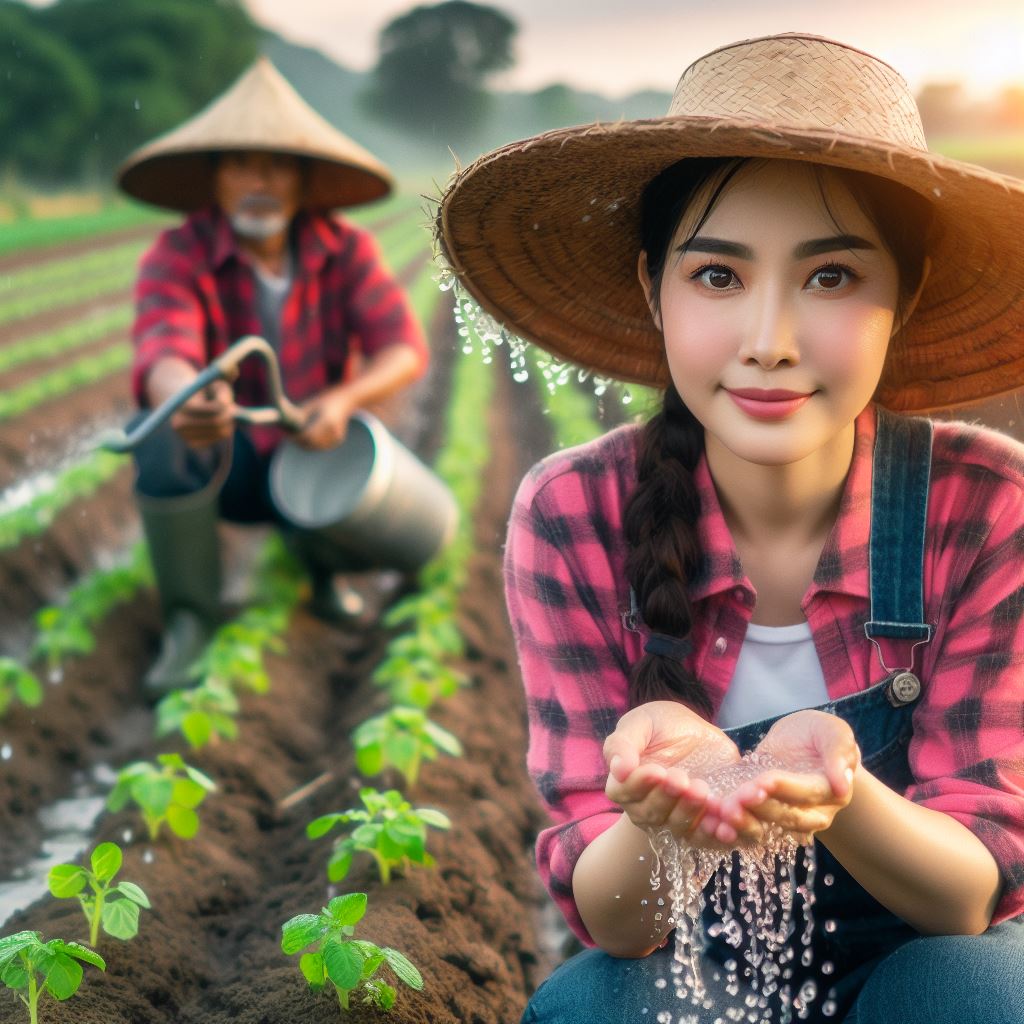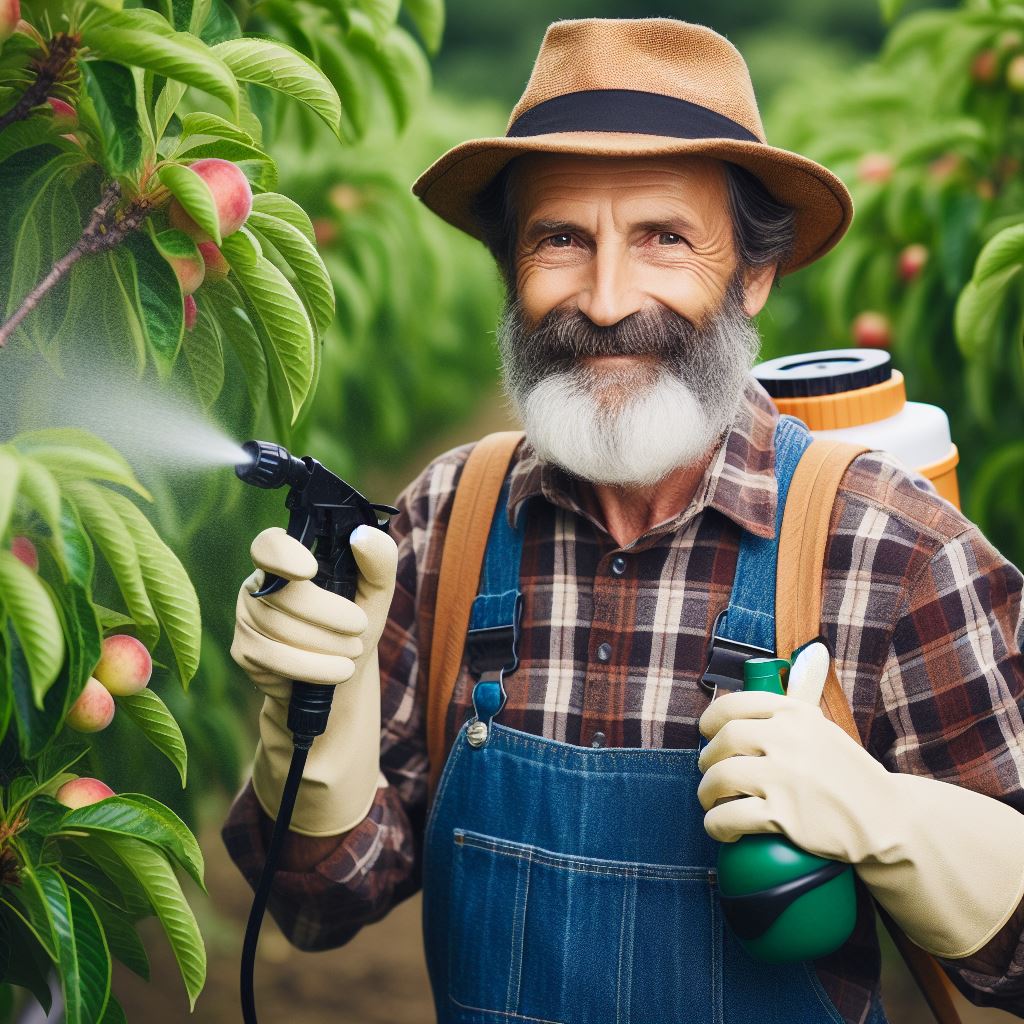Introduction
Importance of maximizing yield while minimizing water use
The efficient use of water in crop production is vital for maximizing yield and sustaining agricultural productivity.
As water scarcity becomes an increasingly pressing issue, it is essential to find innovative ways to optimize water use while still achieving high crop yields.
Brief overview of the topic
In recent years, the challenges posed by climate change and population growth have highlighted the need to improve water management in agriculture.
Traditional irrigation practices can be wasteful, leading to water shortages and environmental degradation.
Therefore, a shift towards sustainable and efficient water use strategies is necessary.
Maximizing yield with minimal water use involves adopting various techniques and technologies.
These include precision irrigation, which utilizes sensors to ensure targeted water application, as well as soil moisture monitoring systems to prevent overwatering.
Moreover, implementing water-saving measures such as mulching, crop rotation, and improved irrigation scheduling can significantly reduce water consumption while maintaining or even increasing crop productivity.
By employing these practices, farmers can enhance water-use efficiency, conserve natural resources, and mitigate the negative impacts of excessive water usage on the environment.
In essence, optimizing water use in agriculture plays a crucial role in maximizing crop yields while mitigating the strain on water resources.
It requires adopting innovative strategies to ensure sustainable and efficient water management practices.
This blog section will explore the various approaches and technologies available to achieve this goal.
Understanding Water Use Efficiency
Definition and importance of water use efficiency
Water use efficiency refers to obtaining maximum yield per unit of water used in agricultural activities. It plays a critical role in sustainable farming practices as water scarcity becomes increasingly prevalent worldwide.
By maximizing the use of available water resources, farmers can meet growing food demands while minimizing the strain on freshwater supplies.
Efficient water use also helps maintain water quality by reducing runoff of fertilizers and pesticides.
Transform Your Agribusiness
Unlock your farm's potential with expert advice tailored to your needs. Get actionable steps that drive real results.
Get StartedFactors affecting water use efficiency in farming
1. Climate and weather conditions
The amount and frequency of rainfall, as well as temperature and humidity levels, influence the availability and distribution of water for crops.
Understanding these factors helps farmers plan irrigation schedules accordingly.
2. Soil type and quality
Soil properties, such as texture, structure, and organic matter content, affect water-holding capacity and drainage. Sandy soils, for example, drain water quickly, whereas clay soils retain water better.
Improving soil quality through management practices like composting and mulching enhances water use efficiency.
3. Irrigation methods
The choice of irrigation system significantly impacts water use efficiency.
Flood irrigation, where water is indiscriminately applied over a field, can lead to significant water losses due to evaporation and runoff.
In contrast, drip irrigation delivers water directly to the plant’s root zone, minimizing losses and maximizing absorption.
Other efficient methods include precision sprinklers and micro-irrigation.
Benefits of improving water use efficiency
1. Water conservation
Efficient water use ensures that every drop is put to productive use, reducing overall water demand and conserving this valuable resource.
It becomes particularly crucial in arid and water-stressed regions, where water scarcity threatens agricultural productivity.
2. Cost savings
By reducing the amount of water required for irrigation, farmers can lower their water bills. Implementing efficient irrigation systems and practices also decreases energy costs associated with water pumping and distribution.
3. Increased crop productivity
Water stress negatively affects crop growth, leading to yield reduction. Improving water use efficiency ensures that crops receive adequate moisture, promoting healthy growth and maximizing yield potential.
4. Environmental sustainability
Efficient water use minimizes the over-extraction of water from sources such as rivers and underground aquifers, preserving these ecosystems.
It also reduces the nutrient and pesticide runoff that can contaminate water bodies, safeguarding water quality and biodiversity.
In fact, understanding and enhancing water use efficiency are essential for sustainable agriculture.
By considering factors like climate, soil, and irrigation methods, farmers can optimize water utilization, conserve resources, and increase crop productivity while minimizing environmental impact.
Implementing efficient irrigation practices not only benefits farmers economically but also ensures a secure and sustainable food supply for future generations.
Selecting the Right Crops
Choosing crop varieties suitable for low water conditions
Growing crops that are well-suited for limited water conditions can significantly increase yield while minimizing water usage. When selecting crop varieties, it is essential to consider their water requirements and adaptability to dry conditions. Here are some factors to consider:
- Drought-resistant varieties: Opt for crop varieties that have a natural ability to withstand drought conditions. These varieties have evolved mechanisms to conserve water and can thrive with minimal irrigation. They often have deep root systems, smaller leaves, and a waxy coating on their leaves to reduce water loss through evapotranspiration.
- Native plants: Native plants are naturally adapted to local climatic conditions and require less water compared to exotic species. They have developed a symbiotic relationship with the environment over time, enabling them to survive with the available resources. These crops are often more pest and disease resistant as well.
- Shorter maturity period: Opting for crop varieties with shorter maturity periods can reduce water usage. Early maturing crops require a shorter duration of irrigation, allowing for the efficient use of water resources. This approach increases the possibility of multiple crop rotations within a limited water season.
Drought-tolerant crops and their benefits
Drought-tolerant crops are an excellent choice for maximizing yield with minimal water use. These crops have unique characteristics that make them resilient to water scarcity. Here are some drought-tolerant crops and their benefits:
- Sorghum: Sorghum is known for its ability to withstand arid conditions and produce high yields even with minimal water availability. It has deep roots that efficiently access the water stored deeper in the soil and can survive on infrequent rainfall.
- Pearl millet: Pearl millet is a hardy crop that can endure not only drought but also high temperatures and poor soil conditions. It requires significantly less water compared to other cereal crops like maize and wheat while maintaining respectable yields.
- Quinoa: Quinoa is a highly nutritious crop that originated in the Andean region of South America. It has the ability to thrive in arid and semi-arid conditions. Quinoa’s deep taproots enable it to access water deep within the soil and tolerate drought stress.
Crop rotation and its impact on water usage
Crop rotation is a sustainable agricultural practice that involves alternating crops in specific sequences on a field over successive growing seasons. It offers several benefits, including reducing pest and disease pressure, improving soil fertility, and optimizing water usage. Here’s how crop rotation can impact water usage:
- Efficient water utilization: Different crops have varying water requirements. By rotating crops with lower water needs alongside those with higher demands, overall water usage can be optimized. This allows for the efficient allocation of limited water resources.
- Improved soil structure and moisture retention: Crop rotation helps improve soil structure, particularly when a combination of deep-rooted and shallow-rooted crops are included in the rotation. The deep roots of some crops can help break up compacted soil layers, allowing for better water infiltration and retention.
- Reduced water-borne diseases: Crop rotation breaks the life cycle of pests and diseases, minimizing water-borne issues. Certain pathogens thrive on specific crop residues left in the soil. By rotating crops, the pathogens are interrupted, reducing the risk of disease spread and decreasing the need for water-intensive disease control measures.
To maximize yield with minimal water use, selecting the right crops is crucial. By choosing drought-tolerant varieties and implementing efficient crop rotation practices, farmers can achieve sustainable agricultural production even in water-limited conditions.
Improving Irrigation Techniques
Drip irrigation systems and their advantages
Drip irrigation systems are a popular choice for maximizing yield and minimizing water use. These systems deliver water directly to the roots of plants, allowing for more efficient water distribution.
The advantages of drip irrigation systems include reduced water wastage, as water is only applied where it is needed.
This helps conserve water and reduces the risk of over-irrigation.
Showcase Your Farming Business
Publish your professional farming services profile on our blog for a one-time fee of $200 and reach a dedicated audience of farmers and agribusiness owners.
Publish Your ProfileAdditionally, drip irrigation systems minimize the weed growth and disease spread that often occur with overhead irrigation methods.
Precision irrigation techniques
Precision irrigation techniques aim to apply the right amount of water at the right time and to the right place. This ensures optimal water usage and maximum crop yield.
One such technique is pivot irrigation, where sprinklers move in a circular motion to evenly distribute water across a field.
Another technique is subsurface drip irrigation, which places drip lines below the soil surface, minimizing water loss due to evaporation.
Monitoring soil moisture levels to optimize irrigation
Monitoring soil moisture levels is crucial for efficient irrigation. By regularly measuring soil moisture, farmers can determine when and how much water to apply.
Various tools can be used for monitoring soil moisture levels, such as soil moisture sensors and tensiometers.
These tools provide real-time data on soil moisture content, allowing farmers to make informed decisions about irrigation scheduling.
Modern technologies and tools for efficient irrigation
Advancements in technology have led to the development of modern tools and technologies for efficient irrigation. These innovations optimize water usage while maximizing crop productivity.
One such technology is the use of drones equipped with thermal cameras and sensors to monitor crop health and moisture levels. This data helps farmers make data-driven decisions about irrigation.
Additionally, smart irrigation systems have emerged, which utilize weather data, soil moisture sensors, and plant water needs to automatically adjust irrigation schedules. These systems ensure that water is applied only when necessary, reducing water waste.
Generally, improving irrigation techniques is essential for maximizing crop yield while conserving water resources.
Drip irrigation systems, precision techniques, soil moisture monitoring, and modern tools and technologies all contribute to achieving this goal.
By implementing these practices, farmers can optimize water usage, reduce water wastage, and increase the overall efficiency and sustainability of their agricultural operations.
It is crucial to prioritize water conservation and adopt these innovative methods to ensure a greener and more resilient future in farming.
Read: Crop Diversity Benefits Revealed

Enhancing Soil Health
Importance of soil health in water retention
Soil health plays a crucial role in water retention as it affects the soil’s ability to hold water. A healthy soil structure promotes better water infiltration and reduces runoff.
Healthy soils also have a higher water-holding capacity, ensuring water availability during dry periods.
Practices to improve soil structure and water-holding capacity
1. Mulching
Mulching is a technique that involves covering the soil surface with organic materials. It helps to reduce evaporation, minimize weed growth, and improve water infiltration.
Mulch also acts as an insulation layer, protecting the soil from extreme temperatures.
2. Cover cropping
Cover cropping involves growing plants during fallow periods to protect and improve the soil. These cover crops help to reduce erosion, improve soil structure, and enhance water infiltration.
They also increase organic matter content, which further enhances the soil’s water-holding capacity.
3. Organic matter addition
Adding organic matter, such as compost or manure, improves soil structure by increasing aggregation. Organic matter acts as a sponge, holding water and releasing it slowly to plants.
It also enhances beneficial microbial activity, which further improves soil health and water retention.
Minimizing soil erosion and runoff
Soil erosion and runoff are major concerns when it comes to maximizing yield with minimal water use. Implementing conservation practices can significantly reduce soil erosion and enhance water retention.
1. Contour plowing
Contour plowing involves plowing across slopes following the contour lines, creating ridges. This helps to slow down water runoff, allowing it to infiltrate the soil before it washes away.
It also helps to improve soil structure and reduce erosion.
2. Terracing
Terracing is another effective technique for minimizing soil erosion on slopes. It involves constructing level platforms along the contour, creating flat areas for crop cultivation.
Terraces reduce the flow of water down slopes, allowing it to be absorbed by the soil.
3. Conservation tillage
Conservation tillage techniques, such as no-till or reduced tillage, help to minimize soil disturbance. By leaving crop residues on the soil surface, these practices protect the soil from erosion.
They also improve soil structure and increase organic matter content, enhancing water retention.
By enhancing soil health through these practices, farmers can maximize crop yield with minimal water use. A healthy soil structure increases water infiltration, reduces runoff, and improves water-holding capacity.
Minimizing soil erosion and runoff further ensures water availability for sustainable and efficient agriculture.
Read: Optimal Soybean Harvesting: When & How
Find Out More: Chemical Pesticides: Pros and Cons Explained
Implementing Water-Saving Practices
Crop scheduling and timing of irrigation
Crop scheduling and proper timing of irrigation can significantly contribute to maximizing yield while using minimal water.
By understanding the water needs of different crops at different growth stages, farmers can schedule irrigation accordingly, ensuring that water is used efficiently.
Water-efficient cultivation methods
- Conservation tillage: Implementing conservation tillage techniques, such as no-till or reduced-till farming, can help retain moisture in the soil, reducing water requirements for irrigation.
- Companion planting: Companion planting refers to planting different crops together to enhance growth and nutrient uptake. Some plants can help retain soil moisture, reducing the need for excessive watering.
- Intercropping: Intercropping involves planting different crops in close proximity to maximize land use and minimize water usage. Certain crop combinations can help create microclimates that reduce water evaporation and increase overall water efficiency.
Managing weeds and pests to minimize water competition
Weeds and pests can compete with crops for water, reducing the available water for crop growth. Effective weed and pest management strategies are essential to ensure that crops receive sufficient water for optimal growth.
Implementing mulching techniques can help suppress weed growth, reducing the competition for water resources.
Mulch acts as a protective layer over the soil, preventing water evaporation and maintaining soil moisture levels.
Moreover, using natural pest control methods such as biological control and integrated pest management can help minimize the need for excessive watering.
Showcase Your Farming Business
Publish your professional farming services profile on our blog for a one-time fee of $200 and reach a dedicated audience of farmers and agribusiness owners.
Publish Your ProfileBy effectively managing weeds and pests, farmers can reduce water competition and maximize water utilization for crop growth.
In all, maximizing yield while minimizing water use is crucial for sustainable agriculture. Implementing water-saving practices is essential to achieve this goal.
Crop scheduling and timing of irrigation, water-efficient cultivation methods like conservation tillage, companion planting, and intercropping, along with effective weed and pest management, are key strategies.
By adopting these practices, farmers can conserve water resources and ensure optimal crop growth, contributing to sustainable and efficient agriculture.
Read: Sustainable Water Use in Farms
Utilizing Advanced Technologies
Remote sensing and satellite imagery for water management
- Remote sensing provides real-time data on soil moisture levels to optimize irrigation schedules.
- Satellite imagery helps identify areas with water stress, allowing targeted water delivery to those regions.
- These technologies enable farmers to make data-driven decisions to maximize yield and minimize water use.
Data-driven decision-making tools for irrigation
- Advanced algorithms analyze data from various sensors to determine plant water needs accurately.
- Farmers can monitor soil moisture, crop health, and weather conditions using smart devices.
- Data-driven tools provide recommendations on when and how much water to apply, optimizing irrigation efficiency.
Adoption of smart systems for irrigation control
- Smart irrigation systems use sensors and weather data to adjust watering schedules based on real-time conditions.
- Soil moisture sensors provide accurate information on how much water the plants require.
- Automated irrigation controllers allow for precise water application, reducing water wastage and costs.
Incorporating these advanced technologies and tools in water management strategies offers several benefits:
- Water conservation: By leveraging remote sensing and satellite imagery, farmers can tailor irrigation precisely to plant needs. This reduces water waste and protects water resources for future generations.
- Increased yield: Data-driven decision-making tools help optimize irrigation practices, ensuring plants receive adequate water. This maximizes crop productivity and brings higher yields.
- Cost savings: By reducing water wastage and optimizing irrigation schedules, farmers can lower their water bills. This reduces operational costs and improves profitability.
- Enhanced precision: Smart systems allow farmers to deploy irrigation resources precisely where they are needed, ensuring uniform water distribution across fields.
- Environmental sustainability: Efficient water management practices contribute to environmental conservation by minimizing the impact on aquatic ecosystems and reducing energy consumption for pumping water.
- Adaptability to changing conditions: Advanced technologies enable farmers to monitor soil moisture levels and respond promptly to changing weather patterns. This adaptability helps farmers cope with drought conditions, ensuring crop survival and maintaining agricultural productivity.
- Improved resource management: By utilizing data-driven tools, farmers can track water usage patterns, identify inefficiencies, and implement strategies to optimize water allocation. This helps ensure the long-term sustainability of agricultural practices.
Therefore, advanced technologies play a vital role in maximizing yield with minimal water use.
Remote sensing and satellite imagery aid in precise water management, while data-driven decision-making tools and smart irrigation systems optimize irrigation practices.
By adopting these technologies, farmers can conserve water, increase yield, save costs, and contribute to environmental sustainability. It is crucial for the agricultural sector to embrace these advancements to ensure a sustainable future for farming.
Read: Best Times to Harvest Corn: Key Tips & Tricks
Conclusion
Recap of key points discussed
Throughout this chapter, we have explored various strategies for maximizing crop yield while minimizing water consumption.
We started by highlighting the importance of water in agriculture and the need to adopt water-efficient practices.
We then discussed the use of precision irrigation techniques, such as drip and micro-sprinkler systems, which help deliver water directly to plant roots, reducing wastage. Additionally, we touched upon the significance of soil moisture sensors and data-driven decision-making in optimizing water usage.
Moreover, we emphasized the role of crop selection, including drought-tolerant varieties and cover crops, in enhancing water use efficiency.
Finally, we highlighted the benefits of mulching, conservation tillage, and crop rotation in reducing water loss through evaporation and transpiration.
Encouragement to implement water-efficient practices
It is crucial for farmers and stakeholders in the agricultural sector to embrace water-efficient practices.
By adopting the strategies discussed, farmers can not only ensure the sustainability of their farms but also contribute to conserving water resources for future generations.
Implementing precision irrigation techniques, utilizing soil moisture sensors, and selecting appropriate crops are all steps that can lead to improved water use efficiency and increased crop yield.
Farmers should recognize that their actions have a significant impact on the environment and the global water crisis. By taking responsibility and adopting efficient water management, farmers can be part of the solution.
Future prospects for improving water use efficiency in farming
The future of water use efficiency in farming is promising, with ongoing advancements in technology and research.
Innovations such as remote sensing, machine learning, and artificial intelligence hold the potential to revolutionize water management practices in agriculture.
These technologies can provide real-time data and insights, enabling farmers to make more informed decisions about irrigation, crop selection, and water conservation.
Moreover, collaborations between farmers, scientists, and policymakers are crucial in developing sustainable water management strategies and promoting their widespread adoption.
By embracing these future prospects, we can strive towards a more sustainable and water-efficient farming industry.




